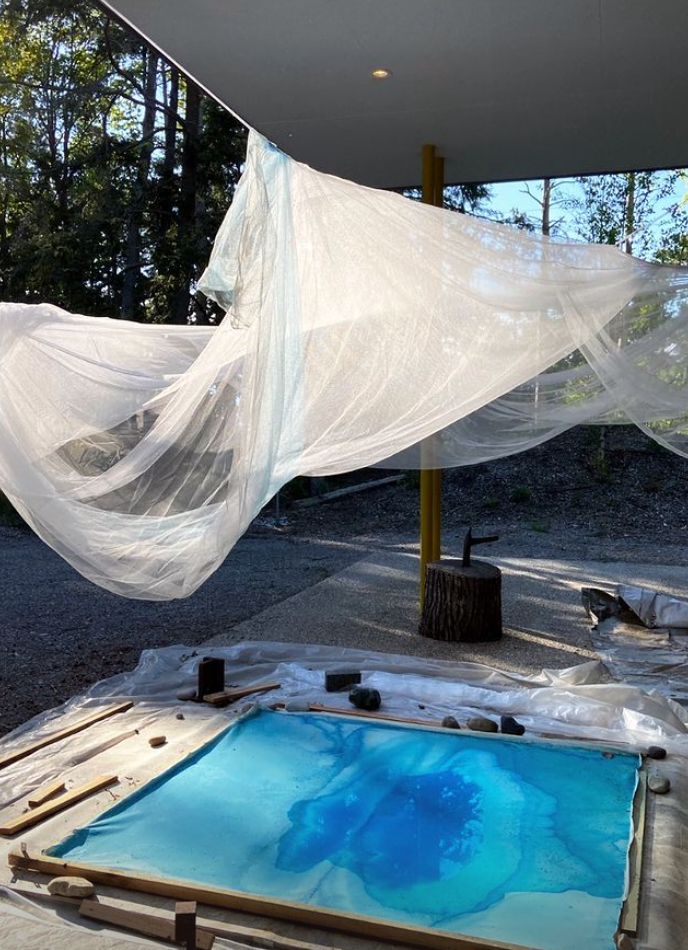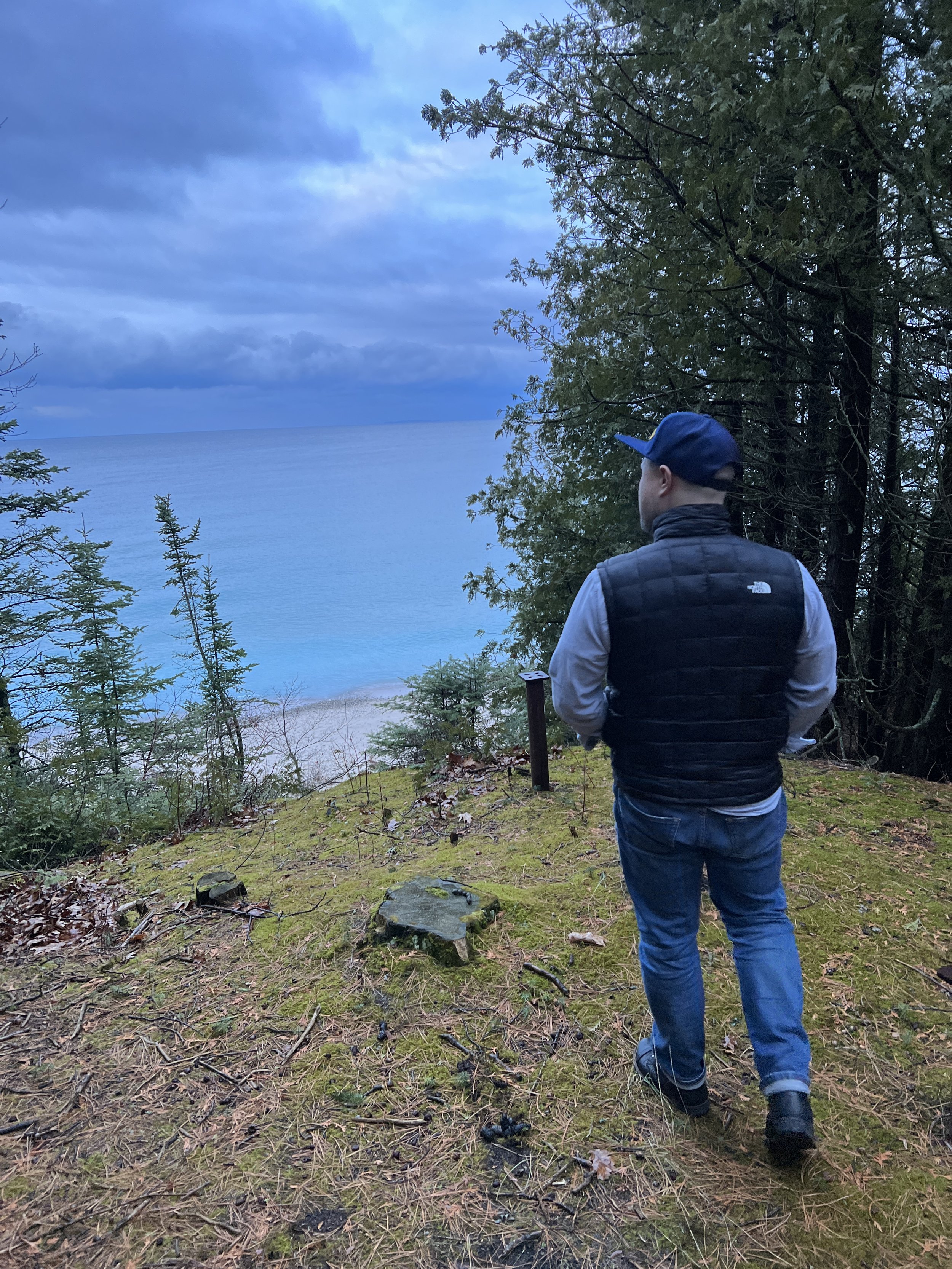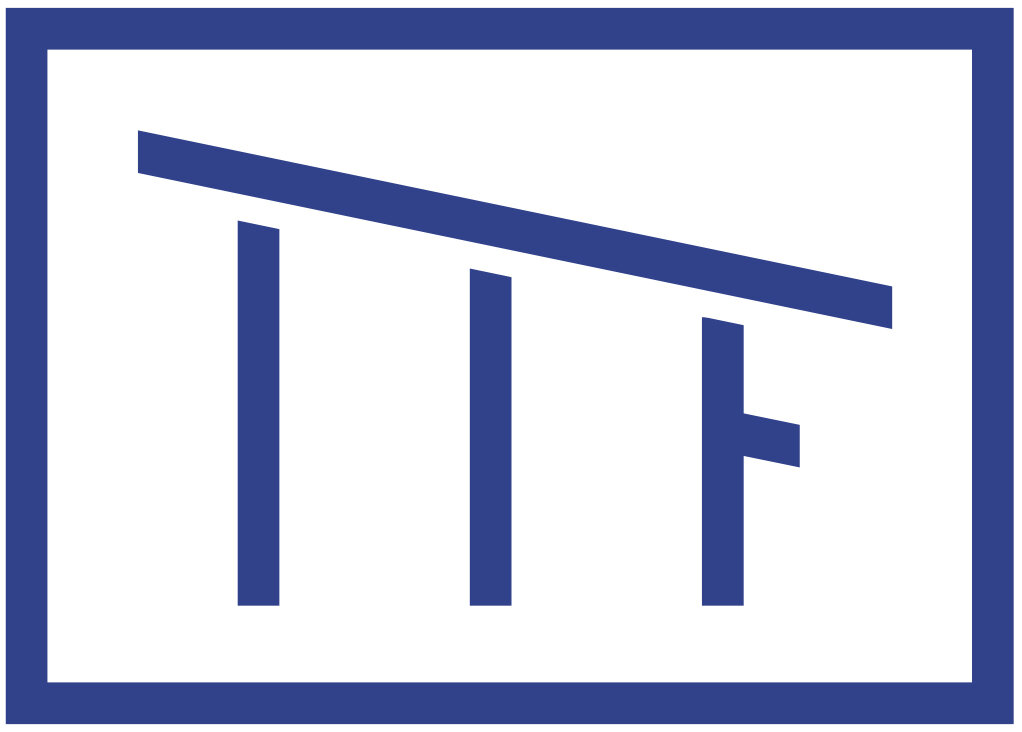




Photo by Vaune Trachtman

2021 Pilot Artist Johnny Coleman


2021 Inaugural Artist-in-Residence Vaune Trachtman

Set up by 2022 Artist-in-Residence Ahavani Mullen

FAQs
Photo by Vaune Trachtman
Q: How are artists selected for a Tusen Takk residency?
A: Primarily, artists are selected from applications to an open call submitted via SlideRoom. We convene a new panel for each call consisting of staff, artists, resident alumni, curators, and arts professionals to offer their insights into the selection process.
Q: Who is invited for a Tusen Takk residency?
A: At this time, Tusen Takk’s facilities are equipped to host visual artists working in photography, painting, book arts, printmaking, sculpture, and fiber arts, as well as creative writers and music composers. We look for ideas and work that will affirm and enrich the human spirit, giving form to chaos and perception to beauty.
The unifying characteristic of artists invited to Tusen Takk is that their work exemplifies excellence and has (or could) significantly contributed to their artistic field. Tusen Takk welcomes applications from mid-career and established artists. Artists should be self-motivated so they can be productive in the relative isolation afforded by a residency at Tusen Takk and open to sharing insights with audiences about their work and processes.
Q: Are there any other qualifications for artists-in-residence?
A: Artists should be over 21 and comfortable communicating with Tusen Takk’s English-speaking staff and audiences. Obtaining a visa to enter or stay in the US (if required) is the responsibility of the artist-in-residence. The Tusen Takk Foundation is able to provide a letter of invitation. Artists should ideally have a valid driver’s license.
Q: How many residencies does Tusen Takk host, and how long are they?
A: Tusen Takk hosts approximately eight residencies for one artist, or two in collaboration, between the months of March and December, each ranging from three to eight weeks in length.
Q: Can collaborators, duos, or collectives be in residence?
A: The program is typically meant to house one artist, two in collaboration, or an artist with an assistant. The Guesthouse can accommodate a maximum of four guests, two per bedroom. Due to the limited size of our Guesthouse’s living quarters, we cannot house large collectives or groups.
Notes on applying as collaborators/duos: artists should submit one application that reflects how they will work together. One applicant should be designated the primary applicant and the other(s) named in the “collaborator/assistant” field. Note that only the primary applicant is offered an honorarium. The portfolio can consist of the artists’ collaborative or independent work, and the applicants can propose to work independently or collaboratively in the application’s “proposal” field.
Q: What is provided as part of a residency at Tusen Takk?
A: Artists are offered 24/7 access to all the Studios as well as private accommodation in the Tusen Takk Guesthouse. Artists are provided with an honorarium of $625/week to help cover residency-related costs, 24/7 access to the Tusen Takk Library, a vehicle for local transportation, and access to the Library & Collection by appointment. While residents enjoy relative solitude, it is possible that a local artist or a Tusen Takk staff person will use one of the unoccupied studios from time to time during the residency. If complete isolation is desired, resident artists can pre-arrange for their residency to be undisturbed.
Q: What is required from the artist during a residency?
A: Since part of Tusen Takk’s mission is to enhance the local artistic culture, artists are highly encouraged to engage once with the regional arts community when in residence. We look at this as a form of giving something back to the artistic culture in our region. The context and form of this engagement are very flexible and can be worked out with our staff after acceptance of the residency. In the past, artists have hosted a private workshop or studio visit, given a public presentation or performance, or mounted an exhibition of their work (examples here). Tusen Takk welcomes proposals from the artist prior to and/or during their residency for this public engagement opportunity. Our staff will work in close collaboration with residents to coordinate all aspects of the engagement.
Artists are asked to donate a work (depending on what’s produced) to the Foundation’s collection and to contribute content to the Foundation’s social channels and print publications. Artists are also encouraged to bring a book to leave behind to share with future resident artists.
Q: What partner organizations could be a place for public events?
A: Tusen Takk has relationships with several arts and cultural organizations in the region for public exhibitions, workshops, performances, presentations, etc. Among them are the Tusen Takk Channel at Commongrounds, the Old Art Building in Leland, MI, the Dennos Museum in Traverse City, Interlochen Arts Academy, and Northwest Michigan College’s Art Department.
Q: Where do the artists-in-residence live and work?
A: The residents have private living quarters in the Guesthouse located across a private road from the Tusen Takk Main House (Director’s home). The Studios are attached to the living quarters, offering the artist 24/7 access. The entire property is on a six-acre wooded site with an outdoor contemplation overlook, beach access to Lake Michigan, and a pavilion in the forest that has a concrete pad, electrical, and water service. Tusen Takk is located on private property and is not open to the public.
Q: What does it cost to participate in a residency?
A: There is no fee for the artist-in-residence. An honorarium is provided to the artist to help cover residency-related costs.
Q: What should artists-in-residence bring?
A: Artists are welcome to ship materials and personal or household items prior to their arrival. In Michigan, it’s a good idea to plan for seasonal weather extremes.
Q: Can artists-in-residence bring their family?
A: Since the Guesthouse was primarily designed to accommodate the artist-in-residence, and a residency is meant as a time for solitude, work, and reflection, an artist may have a spouse or partner join them for up to 7 days during the course of their residency. Due to safety concerns related to the environment and studio equipment, we ask that children only make visits for a weekend (or two) in the middle of a residency, with the expectation that the artist will take time away from their work to fully supervise their children for this short period of time.
If the artist plans to host partners, spouses, or family at any point during the residency, they should indicate “yes” on the application and, if selected for an interview, discuss their intentions with the Director prior to accepting a residency.
Q: Can artists-in-residence bring a pet?
A: Tusen Takk is open to accommodating a quiet, well-behaved dog in the Guesthouse and studios. Proof of the dog’s current vaccinations and heartworm/tick medications will be requested prior to arrival. Cats and other animals are not permitted.
Q: Is there financial assistance?
A: An honorarium of $625/week is available for invited artists to offset residency-related costs including travel, shipping, materials, and day-to-day living expenses during the residency.
Q: Should artists-in-residence provide their own transportation?
A: Tusen Takk provides access to a vehicle during the residency so long as the artist has a valid driver’s license and a clean Motor Vehicle Report for insurance purposes. Artists are welcome to bring their own vehicle and are offered parking free of charge. Leelanau County and the Traverse City region have limited public transportation and taxi/ride share service.
Q: What is the studio environment like?
A: The studios are fully-conditioned spaces with digital thermostats. Humidity is carefully controlled in the printing studios for the sake of paper and ink adhesion. Generally, all studios are kept at 68 degrees F but this can be adjusted.
Q: What is in the studio space and how large can the artist-in-residence work?
A: Descriptions and photos of the studios can be found here.
Q: Do artists have to demonstrate a level of proficiency before they’re able to use the equipment in the studios? A: Yes, especially for the equipment in the woodshop (for safety reasons).
Q: What studios are available for composers?
A: We do not currently have a "dull acoustics" room but we could make such a place. Tusen Takk's painting studio has an acoustic ceiling (plywood panels with tens of thousands of holes, backed with acoustic foam). Fabric material could easily be hung from the studio's walls, which have artwork hanging rails installed along both non-windowed sides. If the windowed painting studio is still too "bright," we could outfit the walls of one of the smaller basement rooms with sound-absorbing materials to make such a room. We are also open to placing a grand piano in the painting studio, should a composer desire such an instrument.
Q: Is technical assistance provided to the artists-in-residence?
A: The Foundation may be able to arrange technical assistance if given sufficient advance notice. Artists should discuss assistance needs with the Director prior to accepting a residency. Please be in touch with us at info@tusentakk.org if you would like suggestions for a photogravure workshop to learn in advance of a residency.
Q: Can the artists-in-residence bring an assistant?
A: Artists may bring an assistant to help facilitate their project, especially if the scope of the project is beyond one person’s capacity. Logistics should be worked out in advance with the Director. Artists who bring an assistant with them are responsible for directly supervising the assistant, who must work exclusively on the artist’s work. A second bedroom in the Guesthouse is available for this purpose. Assistants are not offered an honorarium.
Q: Can a guest visit the artist-in-residence at the studio?
A: Tusen Takk is located on private property and not open to the public. The artist can request permission for day visitors from the Director.
Q: What materials are offered?
A: Artists-in-residence should coordinate their material needs with the Director. Certain materials can be available on a case-by-case basis.
Q: Can the artist-in-residence bring their own materials?
A: Yes. Artists should consult staff prior to bringing or shipping their own materials and tools.
Q: What are the hours the artist-in-residence can work in the studio?
A: The Guesthouse’s living quarters are joined to the studios. Access to the studios is available 7 days a week, 24 hours a day.
Q: How do artists-in-residence transport their work home?
A: Artists are responsible for packing their work. Shipping options should be discussed with staff in advance of the residency.
Q: Are there art supply stores in the area?
A: Art supply stores are very limited in this area. Most supplies should be ordered online for delivery either before or during a residency.
Q: What is the climate like?
A: The area's location on the 45th Parallel (midway between the North Pole and the equator) provides it with four distinct seasons. The climate is cold and temperate.
Q: Is there anything I should know about the natural environment?
A: We are fortunate to have a safe natural environment with no biting insects (no black flies, very few mosquitoes) and no venomous snakes. In May, small midges do swarm on the beach and fruit flies are abundant from mid-September through the end of October due to nearby cherry and apple orchards.
Q: Where is the nearest airport?
A: Cherry Capital Airport (TVC) is located in Traverse City and is approximately 45 minutes by car from Tusen Takk.
Q: What is the community like?
A: Leland is a residential village located on the Leelanau Peninsula, a sliver of land between Lake Michigan and Lake Leelanau. Tusen Takk, by car, is approximately 5 minutes from Leland and 35 minutes from Traverse City. Traverse City, population 16,000, is also on the shore of Lake Michigan. It is a small, growing city with many options for culture, outdoor recreation, wineries, restaurants and craft breweries. Read more in the NYTimes’ “36 Hours in Traverse City, MI” and Time Out’s “10 Best Things to do in Traverse City.”

